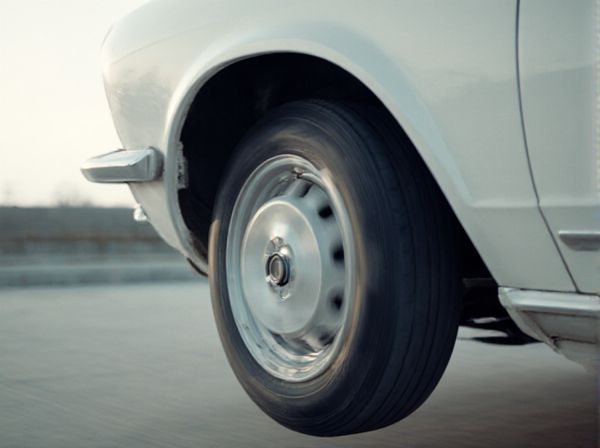
Photo illustration: Flow-formed vs Gravity Cast Wheel
Flow-formed wheels offer enhanced strength and reduced weight by stretching and compressing the aluminum during manufacturing, resulting in improved performance and fuel efficiency. Gravity cast wheels are produced by pouring molten aluminum into molds, making them more affordable but heavier and less durable compared to flow-formed options. Your choice depends on whether you prioritize cost savings or the superior strength and lighter weight of flow-formed wheels.
Table of Comparison
| Feature | Flow-Formed Wheel | Gravity Cast Wheel |
|---|---|---|
| Manufacturing Process | Aluminum billet stretched and formed under high pressure | Molten aluminum poured into molds by gravity |
| Weight | Lighter due to denser material structure | Heavier, less dense grain structure |
| Strength | Higher tensile strength, improved durability | Lower strength, more prone to cracks |
| Cost | More expensive due to complex process | More affordable, simpler production |
| Performance | Better handling, improved acceleration and braking | Standard performance, adequate for daily use |
| Common Uses | Sports cars, high-performance vehicles | Economy cars, general purpose wheels |
Introduction to Flow-Formed and Gravity Cast Wheels
Flow-formed wheels utilize a manufacturing process that stretches and compresses forged aluminum billets while spinning, resulting in increased density and tensile strength along the rim, which enhances durability and performance. Gravity cast wheels are produced by pouring molten aluminum into molds and allowing it to cool naturally; this method is more cost-effective but typically yields a heavier and less robust wheel. The structural integrity of flow-formed wheels often provides better resistance to impacts and improved weight-to-strength ratio compared to gravity cast wheels.
Understanding the Wheel Manufacturing Process
Flow-formed wheels are created by applying pressure to a cast wheel while it spins, enhancing its strength and reducing weight through stretched and aligned aluminum grains. Gravity cast wheels involve pouring molten aluminum into a mold and allowing it to solidify naturally, resulting in a less dense structure with lower production costs but reduced mechanical properties. Understanding these manufacturing differences helps in selecting wheels based on performance needs, durability, and budget constraints.
Key Differences: Flow-Formed vs Gravity Cast Wheels
Flow-formed wheels undergo a manufacturing process where aluminum billets are heated and shaped under high pressure, producing a denser, stronger structure with improved tensile strength compared to gravity cast wheels. Gravity cast wheels are created by pouring molten aluminum into molds and allowing it to cool naturally, resulting in lighter but less durable wheels with lower mechanical strength. This difference in production methods affects weight, strength, and performance, with flow-formed wheels offering enhanced rigidity and impact resistance ideal for high-stress driving conditions.
Strength and Durability Comparison
Flow-formed wheels exhibit enhanced strength and durability due to the metal stretching and compressing during the manufacturing process, resulting in a denser and more resilient wheel structure. Gravity cast wheels, produced by pouring molten aluminum into molds, often contain more porosity and microvoids, making them generally less robust and more prone to cracks under stress. The superior mechanical properties of flow-formed wheels offer better resistance to impact and deformation, making them a preferred choice for performance and durability-focused applications.
Weight Considerations and Performance Impact
Flow-formed wheels weigh significantly less than gravity cast wheels due to the forging-like process that compresses and stretches the aluminum, enhancing strength while reducing material thickness. This weight reduction improves acceleration, braking, and overall vehicle handling by lowering unsprung mass. Performance gains from flow-formed wheels include increased responsiveness and fuel efficiency, contrasting with the heavier gravity cast wheels that may compromise dynamic driving characteristics.
Cost Analysis: Which Wheel Offers Better Value?
Flow-formed wheels typically offer better value due to their balance of strength and lower weight, which enhances vehicle performance and fuel efficiency compared to gravity cast wheels. While gravity cast wheels are generally less expensive upfront, their heavier weight and reduced durability may lead to higher long-term costs through increased wear and potential replacements. Analyzing overall cost effectiveness, flow-formed wheels present a superior investment by combining moderate price with enhanced performance and longevity.
Aesthetic and Design Flexibility
Flow-formed wheels offer superior aesthetic appeal due to their sleek, lightweight design and precise contours, allowing for intricate patterns and finishes that enhance vehicle appearance. Gravity cast wheels provide greater design flexibility because the casting process allows for a wider variety of shapes and sizes, accommodating custom styles and bold aesthetics. The choice between flow-formed and gravity cast wheels depends on prioritizing either refined lightweight sophistication or extensive creative design options.
Common Applications and Vehicle Suitability
Flow-formed wheels, known for their superior strength-to-weight ratio, are commonly used in performance and sports vehicles where durability and weight reduction are critical for handling and acceleration. Gravity cast wheels, typically heavier and less expensive, are suited for everyday passenger cars and light trucks, providing acceptable performance for daily driving conditions. High-performance vehicles benefit from flow-formed wheels due to their enhanced structural integrity, while gravity cast wheels are preferred for budget-conscious buyers prioritizing aesthetics and cost.
Pros and Cons of Flow-Formed Wheels
Flow-formed wheels offer enhanced strength and durability compared to gravity cast wheels due to their advanced manufacturing process that stretches and compresses the wheel's aluminum alloy, resulting in a denser and more rigid structure. These wheels provide improved performance benefits such as reduced weight, better handling, and increased resistance to bending or cracking under stress. However, flow-formed wheels typically come at a higher cost and may have limited design options compared to the more affordable and easily produced gravity cast wheels.
Pros and Cons of Gravity Cast Wheels
Gravity cast wheels offer an affordable manufacturing process that results in moderately strong wheels with consistent structural properties. These wheels typically have higher porosity compared to flow-formed wheels, which may lead to reduced strength and durability under high stress conditions. While gravity cast wheels provide a cost-effective option for everyday driving, they may not perform as well in high-performance or demanding environments due to their comparatively lower tensile strength.
 caratoz.com
caratoz.com